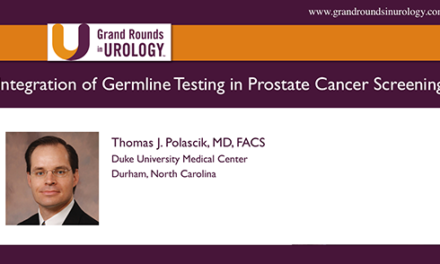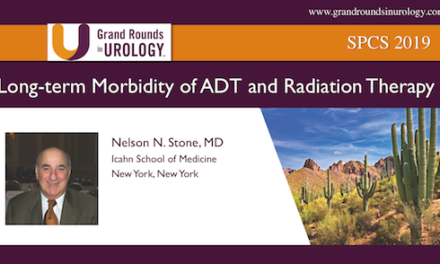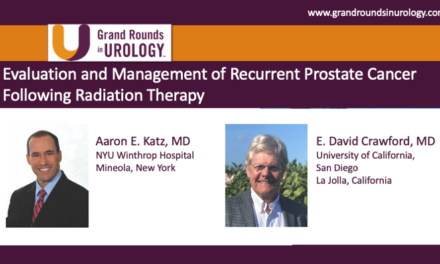Dr. Thomas Keane spoke at the 25th International Prostate Cancer Update on Friday, January 23, 2015 on “LHRH Agonists and Antagonists: A Review of What Is Known and Recent Data.”
Presentation
Keywords: ADT, testosterone-FSH control, cardiovascular disease, LHRH agonists, LHRH Antagonists
How to cite: Keane, Thomas. “LHRH Agonists and Antagonists: A Review of What Is Known and Recent Data” Grand Rounds in Urology. April 13, 2015. Accessed Dec 2024. https://dev.grandroundsinurology.com/prostate-cancer-thomas-keane-lhrh-agonists-and-antagonists/.
Transcript
LHRH Agonists and Antagonists: A Review of What Is Known and Recent Data
I was asked to talk about the antagonists. I was asked to give a history, and really I’ve looked at it from a review of what is known and there has been three or four papers published in 2014 which we should look at.
We’re going to examine the efficacy and benefits of GnRH agonist and antagonist and we’re going to describe the safety profile of both these agents in terms of their control of skeletal metastatic disease and cardiovascular events.
Now first of all, if there had been an antagonist first, there would probably have never been an agonist. But the problem was in position 6 as Marc mentioned earlier, and it wasn’t until there was a neutral D-uretal-alkal amino acid that could be manufactured and placed in there that we actually got reasonable antagonists. Now they all have a problem with histamine release and this synthesized agent dropped that down to an acceptable level.
There are four listed here, the cetrorelix was the one used for BPH, the abarelix was the first to hit the American market really in a big way for prostate cancer, and then we had degarelix. Abarelix, well you heard the data from Marc, I’m not going to repeat it. Just suffice to say that it did everything that degarelix does. It is still available in Europe. It was voluntarily withdrawn in the U.S. in 2008. Primarily I think because of an escape phenomenon.
Here you can see the differences between the two. You see that there is a profound suppression of FSH, LH, no microsurges, and it continues through to prolong suppression of both FSH and LH and testosterone, as opposed to the agonist where it is an almost temporary in some situations particularly if you look at FSH and serum magnum and phosphatase which I’ll deal with later.
One important thing to mention. I think this question has been put to rest. It was originally raised by Morote and Perachino, which basically said that the initial testosterone nadir achieved on the introduction of ADT is predictive of your clinical outcomes.
So the Canadians and Laurie Klotz in particular looked at the time to hormonal resistance by median T in year 1 of their continuous arm of their intermittent study. This paper is going to be published in the next month so Laurie doesn’t mind me presenting this slide anymore.
Having said that, it shows in a large, over 600 patients, the same thing transpires. So I think we can now say that the two original papers which we hypothesis generating have more or less been proven to be true. The lower you go, the better it is. If you get below 20, and I believe that the new standard should be 20 ng/dl not 50 ng/dl, I think you’re going to see a better result.
Looking at the pivotal phase 3 trial, you’ve all seen CS21 and 21A the extension study. This was how degarelix got approved in 2008. You know there were two maintenance arms. It turned out that 80 mg was the acceptable arm because there was no difference when you used 160 mg.
And the primary endpoint was achieving a testosterone of less than 50 ng/dl and that’s what the FDA wants. The secondary endpoints were very interesting, not frequently spoken about, but part of the trial. The proportion of patients who develop testosterone surged; the proportion of patients with testosterone below 50 ng/dL; the percentage change in PSA from baseline to day 28, in other words the first month; frequency and severity of adverse events; and most importantly the frequency of PSA progression.
Here you see the typical slide that we all know now. You see the surge, you see immediate castration in 56 of the patients by day 1, and 95% of the patients by day 3 if they’re on the antagonist. And also I will go back to that just for a second, I can’t get to it now, but it took 28 days before the two testosterone curve came together. The same was seen with PSA control, it took 56 days before the two curves came together.
Interestingly, the last secondary endpoint that I mentioned, degarelix significant reduced the risk of PSA progression in the patients that it was used and compared to the agonist.
That was a surprising finding and furthermore it was more or less limited to those patients with the higher PSAs and metastatic disease.
Also, at our institute, Fritz Schroder showed this, look at the serum alkaline phosphatase control. Here it is after seven months you see it start to come back up towards normal on the agonist, but on the antagonist, it remains effectively suppressed.
So at the end of one year, the FDA said, okay, well that’s very good, it looks good, but let’s look at the extension study because there was that question that there might be an escape at over one year. They wanted everybody treated with degarelix and they insisted that the patients on the leuprolide should be converted across to degarelix.
This is what we saw. Here is the one year study with a difference in PSA progression or androgen dependent disease. Here’s the events rate. Once these patients were crossed over, you see the slope of the curve went back to the degarelix curve, and the events rates went from 0.20 down to 0.08, a highly significant difference.
We also, if you look, FSH. Here’s FSH on the agonist. Here’s FSH on the antagonist. Here’s what happened when you crossed from the agonist to the antagonist, a further 63% reduction in FSH levels. Now again, this isn’t a new. Marc Garnick had showed this in 2000. Here’s his original abarelix data looking at CAB versus abarelix in the control of FSH and you see the very same thing.
What about FSH? People say well what’s FSH? It’s all crap. Well they said the same thing about that, about prostate cancer cells producing testosterone. That was Jim Moller was the first one to identify that. He didn’t understand what it meant. Nobody did, but when he biopsied castrate resistant prostate cancer patients and compared it to BPH patients, he found that there was only 50% difference between the testosterone levels. Everybody scratch their head. Then two or three years later at ASCO we have an abstract on steroidogenic enzyme upregulation and suddenly these people said, gosh, maybe it is real. And then suddenly we found out that the prostate cancer cells are making their own testosterone and that led to the birth of abiraterone.
Same thing here, just because we don’t know about it doesn’t mean it doesn’t exist. This is data from Radu; it was an analysis of samples of 773 patients with prostate cancer. All samples express the FSH receptor whereas normal tissue in this study had no receptor expression. Again, they did colocalization studies and they found that the FSH and the blood vessels were in the same area. They were colocalized together. They also looked at the number of neovascular vessels or new vessel formation in the tumor versus the prostate normal tissue and they found of course there were more new vessels and when they looked at the position of those new vessels, it was at the leading edge of the tumor. If you use a war analogy, you need your shot troops at the front of your army. They’re the guys who are going to do the invading, and that’s what’s happening here.
There is an extremely good article which was published in the Journal of Hematology and Oncology in December 2014. It was turned down in the journal, our journal, but it was David wrote it, and Shally was the third author on it. It goes through the what we know about FSH currently, I would recommend everybody have a look at that because it really is fascinating. And FSH seems to work through the P13 kinase AKT pathway, it produces HIF-1 alpha, which leads to increased VEGFA, which leads to neovascularization. That appears to be the mechanism; again it has to be confirmed.
What about the tolerability of these agents? Again, there was no substantial difference apart from the injection site reaction which was at 33% in the initial dose, 4% on the maintenance dose. That level has been reduced dramatically by using a deep subcutaneous injection as opposed to a superficial one. And secondly, nobody withdrew from the study because of the injection site reactions.
The overall summary for 21 and 21a is that there was faster castration and PSA suppression, no risk of clinical flare; longer PSA progression-free survival especially those in at greatest risk of progression. And for up to five years of treatment PSA progression-free survival has improved and the therapy is well tolerated.
Now, there has been two recent articles which have looked at disease control and cardiovascular outcomes from a pooled database of phase 3 clinical studies. One of them was published just before the end of the year in December. They looked at how does the control of disease outcomes with degarelix versus LHRH agonist compare. There were five studies in it and you see the five studies listed here and once again patients demographic showed no substantial favoritism towards either agent. But what they did find was a superior overall survival with degarelix versus LHRH agonist in all patients.
Now wait a minute, this is the yearlong studies at most. That’s not prostate cancer death, and no, it wasn’t prostate cancer death. What it was was cardiovascular deaths. They also found a lower probability of musculoskeletal events with degarelix versus LHRH agonist in all patients, particularly in the patients of course with metastatic disease. They also found a lower probability of urinary tract events with degarelix versus LHRH agonist. Perhaps because of a faster reduction in the tumor burden thereby avoiding the high residuals of the potential for urinary tract infections.
Then there was a second study which looked at cardiovascular outcomes again from a pooled data analysis but this was Albertson’s data. Now remember ADT is associated with an increased risk of cardiovascular events. LHRH agonist have been linked to increased cardiovascular morbidity, compared to orchiectomy and men with a history of cardiovascular disease are typically most at risk. Degarelix has a distinctly different mechanism, so it’s quite possible that you will not see the same cardiovascular problems, so the risk of cardiovascular events in men receiving agonist are degarelix was assessed in this pooled analysis. Now remember, the increase in risk of cardiovascular disease in men treated with androgen deprivation therapy, be it orchiectomy, estrogen or GnRH agonist, appears to be about 20% to 25% based on the studies to date. Look at some of the other risk factors and they fall into the same area.
Here’s the data. There were over 2,000 patients, nearly 1,500 were on degarelix, 837 were on an agonist either goserelin or leuprolide and there were an equal number of men by percentage with a history of cardiovascular disease. Again the patients were well balanced, there was no favoritism in the patients as you looked at it.
When you looked at the groups overall, all patients, there was a difference between the two, in favor of degarelix in terms of any cardiovascular events, and in terms of death.
Not a huge difference, but when you looked at the patients with a cardiovascular history, there was a highly significant difference between the events and the death rate. And here’s the graph of that.
The summary of the pooled analysis. When treated with degarelix compared with a GnRH agonist in patients with preexisting cardiovascular disease, they had significantly fewer cardiovascular events, the first year of treatment. And had a relative risk reduction of 50% and an absolute risk reduction of 8.2%.
Why? Well, it could be metabolic changes. It could be GnRH receptor activation, or it could be to do with the FSH control levels.
Here are two different fibrotic plagues. Here’s a stable one, here’s an unstable one. Look at the differences in the cap here. The difference is in composition. The difference is in lipid core. And the differences are in the inflammatory state. Much more inflammation present in the unstable cap.
Here is a staining of the plaque and this is GnRH receptors expressed by smooth muscles in the atherosclerotic plaques. Don’t forget, they’re going to be stimulated by the agonist, not by the antagonist.
If you look at T cells, they express GnRH receptors, agonists and antagonists have different effects. Here’s the effect of the agonist. You see stimulation of the T cells, and you see increased proliferation and activity. Here’s the GnRH antagonist, no increase in proliferative activity, complete blockade of receptors with no signal transduction.
Here’s a schematic of what happens. The T cell releases interferon gamma, which prevents collagen synthesis. The collagen that has been synthesized is affected as well by the T cells going to this mononuclear phagocyte, which releases the MMP products which basically breaks down the collagen and results in increased risk of thromboembolic complications and cardiovascular disease.
The conclusions of ADT and cardiovascular disease is when treated with degarelix rather than an agonist, patients with preexisting cardiovascular disease had significantly fewer events during the first year of treatment and a relative risk reduction at 50%. What does this mean for our patient? Well, we’ve got to consider which therapy will treat as prostate cancer effectively. We also consider which therapy will control his disease symptoms effectively and we’ve got to look at side effects.
In the absence of cardiovascular disease, there may well not be a huge amount of difference between the two agents. We need further studies on that. In the presence of cardiovascular disease, I have no doubt as to which agent I’m going to be looking at.
The overall summary between the two types of agents, faster castration onset, PSA suppression, no risk of clinical flare; longer PSA progression-free survival in terms of time to castration resistance of death, and particularly seen in the patients with higher volume disease; improved overall survival; improved control of skeletal metastases; and significantly fewer cardiovascular events during the first year of treatment.
I leave you with this, if you are somebody who has a history of cardiovascular disease and you are going to go on androgen deprivation therapy, you should be treated with degarelix. If you have a PSA which is above 20, or you have known metastatic disease, you should probably be treated with degarelix. I didn’t show this data but there is early data, I would call it hypothesis generating, but if you have a high IPSS score, there is early data which shows that the antagonist does a better job at it.
References
Albertsen PC, Klotz L, Tombal B, et al. Cardiovascular morbidity associated with gonadotropin releasing hormone agonists and an antagonist. Eur Urol. 2014 Mar;65(3):565-73.
http://www.ncbi.nlm.nih.gov/pubmed/24210090
Anderson J, Al-Ali G, Wirth M, et al. Degarelix versus goserelin (+ antiandrogen flare protection) in the relief of lower urinary tract symptoms secondary to prostate cancer: results from a phase IIIb study (NCT00831233). Urol Int. 2013;90(3):321-8.
http://www.ncbi.nlm.nih.gov/pubmed/23258223
Axcrona K, Aaltomaa S, da Silva CM, et al.
Androgen deprivation therapy for volume reduction, lower urinary tract symptom relief and quality of life improvement in patients with prostate cancer: degarelix vs goserelin plus bicalutamide. BJU Int. 2012 Dec;110(11):1721-8.
http://www.ncbi.nlm.nih.gov/pubmed/22500884
Boccon-Gibod L, van der Meulen E, Persson BE. An update on the use of gonadotropin-releasing hormone antagonists in prostate cancer. Ther Adv Urol. 2011 Jun;3(3):127-40.
http://www.ncbi.nlm.nih.gov/pubmed/21904569
Chen HF, Jeung EB, Stephenson M, et al. Human peripheral blood mononuclear cells express gonadotropin-releasing hormone (GnRH), GnRH receptor, and interleukin-2 receptor gamma-chain messenger ribonucleic acids that are regulated by GnRH in vitro. J Clin Endocrinol Metab. 1999 Feb;84(2):743-50.
http://www.ncbi.nlm.nih.gov/pubmed/10022447
Crawford ED, Tombal B, Miller K, et al. A phase III extension trial with a 1-arm crossover from leuprolide to degarelix: comparison of gonadotropin-releasing hormone agonist and antagonist effect on prostate cancer. J Urol. 2011 Sep;186(3):889-97.
http://www.ncbi.nlm.nih.gov/pubmed/21788033
Crawford ED, Shore ND, Moul JW, et al. Long-term tolerability and efficacy of degarelix: 5-year results from a phase III extension trial with a 1-arm crossover from leuprolide to degarelix. Urology. 2014 May;83(5):1122-8.
http://www.ncbi.nlm.nih.gov/pubmed/24661333
Epstein MM, Edgren G, Rider JR, et al. Temporal trends in cause of death among Swedish and US men with prostate cancer. J Natl Cancer Inst. 2012 Sep 5;104(17):1335-42.
http://www.ncbi.nlm.nih.gov/pubmed/22835388
Garnick MB, Campion M. Abarelix Depot, a GnRH antagonist, v LHRH superagonists in prostate cancer: differential effects on follicle-stimulating hormone. Abarelix Depot study group. Mol Urol. 2000 Fall;4(3):275-7.
http://www.ncbi.nlm.nih.gov/pubmed/11062384
Grasso G, Massai L, De Leo V, et al. The effect of LHRH and TRH on human interferon-gamma production in vivo and in vitro. Life Sci. 1998;62(22):2005-14.
http://www.ncbi.nlm.nih.gov/pubmed/9627099
Hedlund PO, Johansson R, Damber JE, et al. Significance of pretreatment cardiovascular morbidity as a risk factor during treatment with parenteral oestrogen or combined androgen deprivation of 915 patients with metastasized prostate cancer: evaluation of cardiovascular events in a randomized trial. Scand J Urol Nephrol. 2011 Nov;45(5):346-53.
http://www.ncbi.nlm.nih.gov/pubmed/21627403
Jacobson JD, Nisula BC, Steinberg AD. Modulation of the expression of murine lupus by gonadotropin-releasing hormone analogs. Endocrinology. 1994 Jun;134(6):2516-23.
http://www.ncbi.nlm.nih.gov/pubmed/8194477
Ketchandji M, Kuo YF, Shahinian VB, et al. Cause of death in older men after the diagnosis of prostate cancer. J Am Geriatr Soc. 2009 Jan;57(1):24-30.
http://www.ncbi.nlm.nih.gov/pubmed/19054189
Klotz L, Miller K, Crawford ED, et al. Disease control outcomes from analysis of pooled individual patient data from five comparative randomised clinical trials of degarelix versus luteinising hormone-releasing hormone agonists. Eur Urol. 2014 Dec;66(6):1101-8.
http://www.ncbi.nlm.nih.gov/pubmed/24440304
Klotz L, Boccon-Gibod L, Shore ND, et al. The efficacy and safety of degarelix: a 12-month, comparative, randomized, open-label, parallel-group phase III study in patients with prostate cancer. BJU Int. 2008 Dec;102(11):1531-8.
http://www.ncbi.nlm.nih.gov/pubmed/19035858
Libby P. Molecular and cellular mechanisms of the thrombotic complications of atherosclerosis. J Lipid Res. 2009 Apr;50 Suppl:S352-7.
http://www.ncbi.nlm.nih.gov/pubmed/19096046
Libby P. Molecular bases of the acute coronary syndromes. Circulation. 1995 Jun 1;91(11):2844-50.
http://www.ncbi.nlm.nih.gov/pubmed/7758192
Lloyd-Jones DM, Leip EP, Larson MG, et al. Prediction of lifetime risk for cardiovascular disease by risk factor burden at 50 years of age. Circulation. 2006 Feb 14;113(6):791-8.
http://www.ncbi.nlm.nih.gov/pubmed/16461820
Mason M, Maldonado Pijoan X, Steidle C, et al. Neoadjuvant androgen deprivation therapy for prostate volume reduction, lower urinary tract symptom relief and quality of life improvement in men with intermediate- to high-risk prostate cancer: a randomised non-inferiority trial of degarelix versus goserelin plus bicalutamide. Clin Oncol (R Coll Radiol). 2013 Mar;25(3):190-6.
http://www.ncbi.nlm.nih.gov/pubmed/23257248
Millar RP, Lu ZL, Pawson AJ, et al. Gonadotropin-releasing hormone receptors. Endocr Rev. 2004 Apr;25(2):235-75.
http://www.ncbi.nlm.nih.gov/pubmed/15082521
Nanda A, Chen MH, Braccioforte MH, et al. Hormonal therapy use for prostate cancer and mortality in men with coronary artery disease-induced congestive heart failure or myocardial infarction. JAMA. 2009 Aug 26;302(8):866-73.
http://www.ncbi.nlm.nih.gov/pubmed/19706860
Radu A, Pichon C, Camparo P, et al. Expression of follicle-stimulating hormone receptor in tumor blood vessels. N Engl J Med. 2010 Oct 21;363(17):1621-30.
http://www.ncbi.nlm.nih.gov/pubmed/20961245
Schröder FH, Tombal B, Miller K, et al. Changes in alkaline phosphatase levels in patients with prostate cancer receiving degarelix or leuprolide: results from a 12-month, comparative, phase III study. BJU Int. 2010 Jul;106(2):182-7.
http://www.ncbi.nlm.nih.gov/pubmed/19912212
Tanriverdi F, Gonzalez-Martinez D, Hu Y, et al. GnRH-I and GnRH-II have differential modulatory effects on human peripheral blood mononuclear cell proliferation and interleukin-2 receptor gamma-chain mRNA expression in healthy males. Clin Exp Immunol. 2005 Oct;142(1):103-10.
http://www.ncbi.nlm.nih.gov/pubmed/16178862
Taylor LG, Canfield SE, Du XL. et al. Review of major adverse effects of androgen-deprivation therapy in men with prostate cancer. Cancer. 2009 Jun 1;115(11):2388-99.
http://www.ncbi.nlm.nih.gov/pubmed/19399748
Tombal B, Miller K, Boccon-Gibod L, et al. Additional analysis of the secondary end point of biochemical recurrence rate in a phase 3 trial (CS21) comparing degarelix 80 mg versus leuprolide in prostate cancer patients segmented by baseline characteristics. Eur Urol. 2010 May;57(5):836-42.
http://www.ncbi.nlm.nih.gov/pubmed/19962227
Van Poppel H, Klotz L. Gonadotropin-releasing hormone: an update review of the antagonists versus agonists. Int J Urol. 2012 Jul;19(7):594-601.
http://www.ncbi.nlm.nih.gov/pubmed/22416801
ABOUT THE AUTHOR
Thomas E. Keane, MD, is Professor and Chairman of the Department of Urology at the Medical University of South Carolina in Charleston. Dr. Keane specializes in managing prostate, bladder, and renal cancers.
An avid researcher, Dr. Keane has served as principal investigator or co-investigator on more than 20 major clinical and preclinical studies. Much of his work focuses on innovative concepts in translational research, including utilizing human tumor xenografts to investigate the efficacy of new therapies as they relate to GU malignancies with particular reference to cytotoxic agents, sphingolipids, and boron-containing compounds. He holds a United States patent for sphingolipid derivatives and their use.
Dr. Keane’s research has led to publication of more than 100 articles peer-reviewed in such journals as The Journal of Urology, Urologic Oncology, and the Journal of Vascular Surgery. He provides editorial services to publications ranging from Urology to the International Journal of Cancer and is co-editor of the text Glenn’s Urologic Surgery, 6th, 7th, and 8th Editions. He is an accomplished speaker, having delivered many presentations to professional societies and symposia throughout the United States and abroad.





